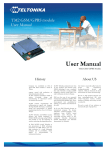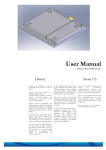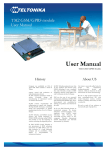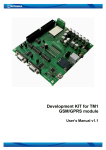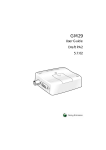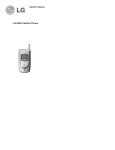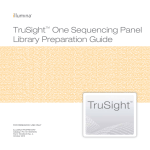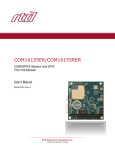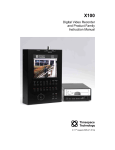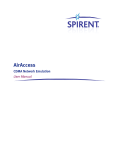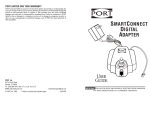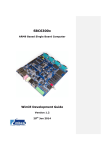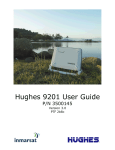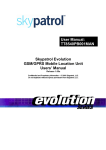Download TM1 User Manual
Transcript
TM1 GSM/GPRS Module User Manual v1.2 History Company was established on 15th of April 1998. Main residence is based in Vilnius. ompany started with production of telecommunication devices. In 2001 company expanded its fields of activity by starting design and manufacturing of electronical systems for wireless data transfer. In 2002 contract of partnership and collaboration was signed with company ProSign GmbH (Germany), considering design and representation of graphic programming interface iCon-L in Eastern Europe. In 2003 Teltonika and NOKIA became partners and started integration of NOKIA M2M technology using NOKIA N12 module. It was the beginning of wireless technology development process. In 2004, NOKIA invited Teltonika to join presentation of M2M technology innovations in CeBIT 2004. It was very high evaluation of a small Lithuanian company and its possibilities, which helped to feel peculiarities of international business. About US In 2004 Teltonika produced more than 10 new products and solutions using EDGE technology. It was a condition that made Teltonika a leader of M2M integration solutions using EDGE not only in Lithuania, but also in Europe. 2005 was the year of two successful international exhibitions: CEBIT 2005 and HANNOVER MESSE 2005. These shows opened new possibilities for offering our products and solutions for all world. In the year 2005 Teltonika became an international company. We became Lithuanian - Finnish Company. A few employees from NOKIA joined Teltonika’s staff. Presently they successfully develop activity of new companies: Teltonika International GmbH (Düsseldorf) and Teltonika International Oy (Helsinki). Our vision is to provide added value for people and companies by creating electronical devices and solutions, which are based on the latest achievements of science and technology. We aim to help people to integrate the latest technologies in real life, what would bring more cosiness, comfort, freedom of mobility and security to their everyday life. We seek to make all our solutions an inconceivable part of people lives. TM1 User Manual v1.2 TABLE OF CONTENTS 1 2 3 4 5 6 7 8 Document Mission.................................................................................................................................................. 3 Glossary ................................................................................................................................................................. 3 Scope of Product.................................................................................................................................................... 6 3.1 Certification ..................................................................................................................................................... 6 Product functions.................................................................................................................................................... 8 4.1 Modem ............................................................................................................................................................ 8 4.1.1 GSM/GPRS modem functionalities.......................................................................................................... 8 4.1.2 Supplementary services .......................................................................................................................... 8 4.1.3 AT-command support .............................................................................................................................. 9 4.1.4 Other basic features ................................................................................................................................ 9 4.2 Voiceband ....................................................................................................................................................... 9 4.2.1 Audio Power Amplifier ............................................................................................................................. 9 4.2.2 Handset and Headset Mode .................................................................................................................. 10 4.2.3 Hands free ............................................................................................................................................. 10 4.2.4 Ringer Mode .......................................................................................................................................... 10 4.2.5 Audio Codecs......................................................................................................................................... 11 4.2.6 Echo canceller/Noise Reduction............................................................................................................ 11 4.2.7 Audio Features....................................................................................................................................... 11 4.3 Mechanical characteristics ............................................................................................................................ 14 4.4 Power supply................................................................................................................................................. 15 4.4.1 Current consumptions............................................................................................................................ 15 4.5 Battery charger feature list............................................................................................................................ 16 4.5.1 TM1 Charger specification..................................................................................................................... 18 4.5.2 Charger Additional Note ........................................................................................................................ 19 4.5.3 TM1 Charger SW driver functional overview ......................................................................................... 21 4.6 Power Saving ................................................................................................................................................ 24 4.7 SMS .............................................................................................................................................................. 25 User Interfaces ..................................................................................................................................................... 26 5.1 SMD Connector............................................................................................................................................. 27 5.1.1 Switching ON of the data module .......................................................................................................... 29 5.1.2 SIM Interface.......................................................................................................................................... 29 5.1.3 Serial Interfaces ..................................................................................................................................... 30 5.1.4 GPIO ...................................................................................................................................................... 31 5.1.5 Keypad................................................................................................................................................... 32 5.1.6 ADC interface / Measurement interface ................................................................................................ 32 5.1.7 SPI ......................................................................................................................................................... 33 5.1.8 I2C bus interface.................................................................................................................................... 33 5.1.9 Electrical Characteristics of SMD connector pins.................................................................................. 33 Serial Port and Data Traffic Behavior................................................................................................................... 36 6.1 Introduction ................................................................................................................................................... 36 6.2 AT command mode at the startup................................................................................................................. 36 6.3 GPRS data communication........................................................................................................................... 37 6.3.1 Introduction to the GPRS IP relaying architecture................................................................................. 37 6.3.2 Context activation .................................................................................................................................. 39 6.3.3 Context deactivation .............................................................................................................................. 39 6.4 CSD data calls .............................................................................................................................................. 40 6.4.1 Outgoing data calls ................................................................................................................................ 40 6.4.2 Incoming data calls ................................................................................................................................ 42 6.5 Power saving and CTS handshake............................................................................................................... 44 6.6 Reference...................................................................................................................................................... 45 6.6.1 External.................................................................................................................................................. 45 Annex 1. Circuit 108/2, +++ behavior for the different &D: summarizing table.................................................... 46 Annex 2. Incoming GPRS context activation ....................................................................................................... 46 2 TM1 User Manual v1.2 1 Document Mission TM1 User Manual contains all information necessary for a successful integration of the system into the application of the customer. Additionally, the customer uses the information described in the User Manual to compare different systems and to finally select the appropriate system for his application. Therefore TM1 User Manual is an important customer document. A particular attention has to be paid while writing the document from the customer point of view. 2 Glossary Acronym 3GPP AC Meaning 3rd Generation Partnership Project Alternating Current ADC Analog to Digital Converter AFC Automatic Frequency Correction APN Access Point Name ASC Asynchronous Serial Interface Controller AT BSS CB CBCH CGU CS AT Command Interpreter Software Subsystem, or attention Broadcasting Satellite Service Cell Broadcast Cell Broadcast Channel Clock Generation Unit Coding Scheme CSD Circuit Switched Data DAI Digital Audio Interface DC Direct Current DCE Data Communication Equipment DCS Digital Communications System DCXO DL Digital Controlled Crystal Oscillator Reception DSP Digital Signal Processing DTE Data Terminal Equipment EBU External Bus Interface Unit EDGE EEPROM EGSM Enhanced Data rates for GSM Evolution Electrically Erasable and Programmable ROM Enhanced GSM EMC Electromagnetic Compatibility ERM Electromagnetic compatibility and Radio spectrum Matters 3 TM1 User Manual v1.2 Acronym Meaning ESD Electrostatic Discharge ETSI European Telecommunications Standards Institute FFS Flash File System FOAT Firmware Over AT commands GND Ground GPIO General Purpose Input Output GPRS General Packet Radio Service GSM Global System for Mobile Communication HDLC High Level Data Link Control HW Hardware JTAG Joint Test Action Group I2C Inter-Integrated Circuit IIR Infinite Impulse Response IMEI International Mobile Equipment Identity I/O Input / Output IP Internet Protocol ISDN Integrated Services Digital Network ISO International Organization for Standardization LCP Link Control Protocol LVD Low Voltage Directive M2M Machine to Machine ME MIDI MS Mobile Equipment Musical Instrument Digital Interface Mobile Station MSC Mobile Switching Centre NOM Network Operating Mode NTC Negative Temperature Coefficient PA PBCCH PC PCCCH Power Amplifier Packet Broadcast Control Channel Personal Computer Packet Common Control Channel PCM Pulse Code Modulation PCS Personal Communications Service PDU Protocol Data Unit PDP Parallel Data Processing 4 TM1 User Manual v1.2 Acronym PICS PIN Meaning Protocol Implementation Conformance Statement Personal Identification Number PIXIT Protocol Implementation Extra Information for Testing PLMN Public Land Mobile Network PMU Power Management Unit PPP Point-to-Point Protocol PPS Protocol and Parameter Selection RAM Random Access Memory RF Radio Frequency RLP Radio LINK Protocol ROM Read Only Memory RTC Real Time Clock RX R&TTED Receiver Radio and Tele Terminal Equipment Directive SAW Surface Acoustic Wave SCCU Standby Clock Control Unit SIM Subscriber Identification Module SMA SubMiniature version A connector SMS Short Message Service SPI Serial Peripheral Interface SSC Serial Synchronous Interface Controller SW Software TCH Traffic Channel TCP Transmission Control Protocol TS Technical Specification TX Transmitter UART UL USB Universal Asynchronous Receiver-Transmitter Reception Universal Serial Bus 5 TM1 User Manual v1.2 3 Scope of Product TM1 is a small, light weight and low power consumption module that enables digital communications services on GSM/GPRS networks for machine to machine, user to user or user to machine wireless applications. These GSM/GPRS data modules are developed in compliance with internal and normative certification requirements. In particular, they will be certified by CE approval report (99/5/EC) and Radio & Tele Terminal Equipment Directive (R&TTED) report following the following standard regulations: • 3GPP TS 51.010-1 rel.99 (Radio spectrum); • EN 301 489–1 and EN 301 489–7 (EMC directive - 89/336/CEE); • EN 60950 (LVD Directive - 73/23/CEE) Requirements for lead-free components are imposed and satisfied. The product implements a dual-band MS; it can be configured to operate in the frequency bands either EGSM 900 MHz, and DCS 1800 MHz (European bands) or GSM 850 MHz and PCS 1900 MHz (America bands). The operative temperature range goes from -20 to +85 °C. The supported power classes for both voice and data services are: • • Class 4 (2W) for GSM/EGSM bands; Class 1 (1W) for DCS/PCS bands; The product implements a Class B Mobile Station; this means the data module can be attached to both GPRS and GSM services, using one service at a time. Network operation modes I to III are supported, with user-definable preferred service between GSM and GPRS. Further functionalities that are implemented on the data module are Mux protocol (27.010) and Firmware Over AT commands (FOAT). 3.1 Certification TM1 GSM/GPRS Data Module is certified by CE approval report and Radio & Telecommunications Terminal Equipment Directive (R&TTED) report. Hereby, Teltonika declares that this GSM/GPRS Data Module is in compliance with the essential requirements and other relevant provisions of Directive 1999/5/EC. The directives that are followed for this data module are described below: 3GPP TS 51.010-1 rel.99 Technical Specification Group GSM/EDGE Radio Access Network and Mobile Station (MS) conformance specification; EN 301 489-01 V1.4.1 Electromagnetic compatibility and Radio spectrum Matters (ERM); ElectroMagnetic Compatibility (EMC) standard for radio equipment and services; Part 1: Common technical requirements; EN 301 489-07 V1.2.1 Electromagnetic compatibility and Radio spectrum Matters (ERM); ElectroMagnetic Compatibility (EMC) standard for radio equipment and services; Part 7: Specific conditions for mobile and portable radio and ancillary equipment of digital cellular radio telecommunications systems (GSM and DCS); EN60950 Standard for safety of information technology equipment: to protect against excessive current, short circuits and earth faults in primary circuits protective devices shall be included either as integral parts of the equipment or as parts of the building installation; 6 TM1 User Manual v1.2 73/23/EEC (Low Voltage Directive) The Low Voltage Directive (LVD) 73/23/EEC seeks to ensure that electrical equipment within certain voltage limits both provides a high level of protection for European citizens and enjoys a Single Market in the European Union. 7 TM1 User Manual v1.2 4 Product functions The features that are implemented on TM1 GSM/GPRS Data Module are reported in TM1 Features List. In the following sections will be described the functionalities integrated in the data module. 4.1 Modem The modem part provides with minimal component’s list all functionality necessary for voice and data transmission over GSM and GPRS network. The modem is divided in an area surrounded by traces on which metal box must be soldered. This area encloses the RF High power components, the remaining passive components of the transceiver, the baseband processor, memory, crystals and power management unit. The modem is designed as a dual-band transceiver, i.e. GSM850 / PCS1900 or EGSM900 / DCS1800. 4.1.1 GSM/GPRS modem functionalities TM1 GSM/GPRS module integrates a full-featured Release 99 GSM-GPRS Protocol Stack, whose main characteristics are listed in the following. Refer to the PICS/PIXIT documentation for a detailed description of the Stack features. The product implements a dual-band MS able to operate in the frequency bands either GSM 850 MHz / DCS 1800 MHz or EGSM 900 MHz / PCS 1900 MHz. The supported power classes for both voice and data services will be: • Class 4 for GSM bands; • Class 1 for DCS bands. The product implements a Class B Mobile Station; this means the data module can be attached to both GPRS and GSM services, using one service at a time. Network operation modes I to III are supported, with user-definable preferred service between GSM and GPRS. Optionally paging messages for GSM calls can be monitored during GPRS data transfer in not-coordinating network operation mode NOM II-III. PBCCH/PCCCH logical channels are supported, as well as CBCH reception. CBCH reception when on PBCCH is supported. GPRS multislot 10 is implemented, implying a maximum of 4 slots in DL (reception) and 1 slot in UL (transmission) and 5 slots on the whole. Finally TM1 GSM/GPRS module supports: • All coding schemes from CS1 to CS4; • Encryption algorithms A5/1 for GSM for GPRS are supported; • CS Data calls are supported in transparent/non transparent mode up to 9.6 kbps; • Bearer service fax Group 3 Class 2.0 is supported. Among access interfaces to DTE, both V.32 and V.110 are provided. 4.1.2 Supplementary services The following supplementary services are provided: • Call Hold/Resume (CH); • Call Waiting (CW); • Multi-Party (MTPY); • Call Forwarding (CF); • Call Divert; • Explicit Call Transfer (ECT); • Call Barring (CB); • CCBS; • Advice of Charge (AoC); 8 TM1 User Manual v1.2 • • • • • • 4.1.3 Calling Line Identification Presentation (CLIP); Calling Line Identification Restriction (CLIR); Connected Line Identification Presentation (COLP); Connected Line Identification Restriction (COLR); Unstructured Supplementary Services Data (USSD); Network Identify and Time Zone (NITZ). AT-command support The modem functionalities and services are provided through a rich serial AT-command interface. Standards of AT commands that are supported on the module are: • GSM 27.005; • GSM 27.007; • Proprietary AT commands. For more details on the commands list and their syntax refer to AT commands Manual; more examples are described in chapter. 4.1.4 Other basic features The following indications and functionalities are supported through the interface of AT Commands: • Display of Called Number; • Indication of Call Progress Signals; • Country/PLMN Indication; • Short Message Indication and Acknowledgement; • International Access Function; • Service Indicator; • Dual Tone Multi Frequency (DTMF); • Subscription Identity Management; • Service Provider Indication; • Abbreviated Dialing; • Power on (external input). 4.2 Voiceband The data module provides the following audio interfaces: • A microphone input; • A high power speaker output; • 1 DAI/PCM interface. Through the mother board the following devices can be used to realize a phone call with TM1 Data Module: • Handset; • Headset. Moreover there is the possibility to realize phone call in hands free mode (through a loudspeaker). All these devices (handset, headset and loudspeaker) are connected to the data module via QFN pins (and Mother Board). 4.2.1 Audio Power Amplifier The audio power amplifier can be used as a voice amplifier for the hands-free functionality and as a melody player amplifier for ringer functionality (see the next sections). The melody player could be the Midi synthesizer or the tone generator. In order to minimize the clipping of the audio signal, the polarization voltage can be adapted to the voltage supply (battery voltage). NOTE!! To be noticed that this output can be used both for a voice call and for the ring tones and could be dangerous for the ear of the user if the volume was set to a high volume. 9 TM1 User Manual v1.2 4.2.2 Handset and Headset Mode A headset and a handset could be connected to the mother board to perform a voice call; refer to the mother board description for the procedure that must be followed for the connection of these devices. The normal voiceband functional mode of the data module is completely handled by baseband: • The microphone signal comes from the audio device and is connected to MIC inputs of baseband; there is no specific pin for the ground of the microphone); • The uplink path of the microphone can be muted; • The ground of the microphone must be connected to the ground of the mother board (if the mother board is connected to the data module); • Voice output from baseband is connected to module with AUON and AUOP; and then to the external audio device. Warning: excessive sound pressure from earphones and headphones can cause hearing loss. 4.2.3 Hands free A true hands-free functionality is implemented using high power loudspeaker, MS microphone and appropriate DSP algorithms for voice band handling (Echo canceller and Automatic Gain control). This functionality is managed via Software. The product is equipped with a power audio amplifier that can drive (with a gain of +2.7dB) an external 8 ohm speaker with 250/350 mW peak. With viva voice operation is intended the possibility to realize a phone call with a loudspeaker and a microphone. The audio signal on the loudspeaker is a mono signal. In viva voice mode of operation, the output signal of baseband is amplified by the built-in Audio amplifier of baseband, and then applied to the Loudspeaker output (outputs are AUON and AUOP). The microphone signal is the signal that comes from the input MIC_BIAS/ MIC. The table below shows the pin number related to the analog audio signals. 4.2.4 Name PIN # I/O I/O type Description AUOP AUON MIC MIC GND 43 44 46 45 O O I Analog Analog Analog PWR Balanced power audio out Balanced power audio out Handset microphone bias (+) Handset microphone ground Ringer Mode The data module support 40 tones polyphonic ring tones. The ringer tones are generated baseband built-in generator and then they are amplified by internal amplifier before being applied to loudspeaker through the pin of module AUON and AUOP. For ringing the gain of the audio amplifier is -1.2 dB. Polyphonic ring-tones can be generated by an internal MIDI synthesizer, which runs at 16 or 32 KHz sample frequency and can sum up to 40 voices at 16 kHz sampling rate. The synthesizer output is only mono and cannot be mixed with TCH voice path (the two are mutually exclusive). To perform in-band alerting during TCH with voice path open, only Tone Generator can be used. The output samples of the synthesizer are post processed by two modules: • High Frequency Shelving Filter: This module is implemented as a first order IIR Filter, which is mainly used for high frequency boost in audio signals. Its transfer function can be controlled by 4 filter coefficients. • Audio Compressor: The audio compressor is a device for manipulating the dynamic range of mono or stereo audio signals. The audio compressor can be controlled by 14 configuration parameters. Polyphonic standard format supported. 10 TM1 User Manual v1.2 The MIDI driver can play: • MIDI files conforming to: o General Midi Level 1.0 with file-format 0 and 1; o General Midi Lite 1.0. • SPMidi (Scalable Polyphony MIDI) files conforming to: o SPMidi 1.0. • iMelody files conforming to: o iMelody v.1.2 specifications. 4.2.5 Audio Codecs The following speech codecs are supported in firmware on the DSP: • GSM Half Rate (TCH/HS); • GSM Full Rate (TCH/FS); • GSM Enhanced Full Rate (TCH/EFR); • 3GPP Adaptive Multi Rate (AMR) (TCH/AFS+TCH/AHS). 4.2.6 Echo canceller/Noise Reduction For better handling of speech calls and audio functionalities, the product supports algorithms for echo cancellation, noise suppression and automatic gain control. 4.2.7 Audio Features The main values referred to the audio part are listed as follows: • Microphone input: o Max (EGMICP1-EGVMICN1): 1.03 V; o Min S/D: 65 dB; o Min Signal-to-noise: 75 dB (gs=+12dB @300-3900Hz GSM mode) o Typ Power supply rejection: 85 dB; o Max Cross talk (RX and TX channels): -65 dB. • Output AUOP/AUON: o Single ended output load capacitance: 10 nF; o Power supply rejection: 66 dB; o Max Inductive load: 400 µH. In the following is reported the microphone input equivalent circuit that has been used to evaluate the impedance and the transfer function: 11 TM1 User Manual v1.2 MIC 1 Baseband Chipset C9 C5 5p MICN1 EGMICN1 100n R7 50k C10 C6 R6 2k R4 1.5k V2 C4 27p AC1 EGMICP1 0 5p 100n R5 Baseband Chipset 1.5k R9 C3 10µ VMICP V3 100 C13 1n 2.2V Figure 4-1 : TM1 microphone input equivalent circuit In the following is reported the transfer function of the (EGMICN1-EGMICP1)/VMICN1: Figure 4-2: Transfer function of the microphone part Finally is displayed the input impedance of the MIC1: 12 TM1 User Manual v1.2 Figure 4-3: Input dialing of MIC1 13 TM1 User Manual v1.2 4.3 Mechanical characteristics The number of RF shield required is 1. The dimensions of the data module without shields are reported in the following: • 32.00 mm x 20.80 mm x 2.87 mm Figure 4-4: TM1 Mechanical Dimensions The weight is less than 5 g. No natural rubbers, no hygroscopic materials nor materials containing asbestos are employed. 14 TM1 User Manual v1.2 4.4 Power supply TM1 Data Module can be supplied by a power supplier connected with the mother board. The voltage is provided to the Data Module through the data module pins that provides a voltage value VBAT on pins 1, 2, 51, 52. The range of VBAT is between 3.5 V and 4.2 V, while typically its value is 3.8 V. The minimum current that must be provided to the data module through the power supplier is about 2 A; the maximum value is 2.5 A (peak). Description Min Typ Max Supply voltage 3.5 V 3.8 V 4.2 V The VBAT voltage is connected with the power management part of the baseband chipset that supplies all components of the data module and derives all needed voltage levels to supply the different circuit parts. The power amplifier is supplied directly by VBAT voltage. The supply domain might have different setting and they are programmed via a dedicated EP_I2C bus (implemented with SW driver) by baseband at startup. All the other programming of the baseband is performed in the same way. 4.4.1 Current consumptions Current consumptions of TM1 module are reported in the following pages. Status Average Current Power OFF < 90 µA Idle Mode < 2 mA Telephony GSM < 300 mA Telephony DCS/PCS < 250 mA GPRS (4+1) attach mode < 2 mA GPRS (4+1) TBF mode @ 850 / 900 MHz < 450 mA GPRS (4+1) TBF mode @ 1800 / 1900 MHz < 450 mA A pins description of module that is enabled to supply the Data Module is reported below. Name PIN # I/O I/O type Description VBAT VBAT 1 2 PWR PWR From 3.5 to 4.2 V (Typ: 3.8 V) From 3.5 to 4.2 V (Typ: 3.8 V) GND 3 PWR Ground GND 6 PWR Ground GND GND MIC_GND GND GND GND VBAT VBAT 17 42 45 47 49 50 51 52 PWR PWR PWR PWR PWR PWR PWR PWR Ground Ground Ground Ground Ground Ground From 3.5 to 4.2 V (Typ: 3.8 V) From 3.5 to 4.2 V (Typ: 3.8 V) Should be connected with pins 2, 51, 52 Should be connected with pins 1, 51, 52 Should be connected with pins 6, 17, 42, 45, 47, 49, 50 Should be connected with pins 3, 17, 42, 45, 47, 49, 50 Should be connected with pins 3, 6, 42, 45, 47, 49, 50 Should be connected with pins 3, 6, 17, 45, 47, 49, 50 Should be connected to microphone GND Should be connected with pins 3, 6, 17, 42, 45, 49, 50 Should be connected with pins 3, 6, 17, 42, 45, 47, 50 Should be connected with pins 3, 6, 17, 42, 45, 47, 49 Should be connected with pins 1, 2, 52 Should be connected with pins 1, 2, 51 15 TM1 User Manual v1.2 4.5 Battery charger feature list Alternatively to the power supplier TM1 Data Module can be supplied through a battery. The supported type for the battery is Li-Ion and Li-Polymer rechargeable only; default system supports 650 mAh nominal. A description of the pins that are enabled to supply the Data Module with a battery is reported below. Name PIN # I/O I/O type Description VCHARGE VCHARGE 4 5 PWR PWR Module Charge Module Charge Should be connected with pin 5 Should be connected with pin 4 In the case that a battery is not used the VCHARGE pins (4 and 5) should be left unconnected. The main features of the battery charger system implemented on TM1 data module are listed in the following: • The supported types for the battery are Li-Ion and Lithium-Ion-Polymer batteries (other type of batteries can be supported in TM1 with dedicated SW); • The default system support 500 mAh (minimum value); the typical value of the battery capacity is 650 mAh; • Charger voltage range goes from 6 to 15 Volts while the charger voltage current is 500 mA; • The supported battery voltage range goes from 3.1 V to 4.47 V; • The charger circuitry generates the power on after battery connection or charger connection; • The charging is optimized for current adjusted in the AC-DC wall adapter charger; • Charger detection supported; • Battery over-voltage detection, battery voltage monitoring; • Protection against over-voltage integrated on the data module; • Pre-charging (e.g. for deep discharged batteries); • Software controlled charging supported. In an electronic (switched) charger, the charge current is usually constant and defined by the electronics control in the charger. The shortest charge times can be reached with constant current charger. The charger circuit can handle the normal AC supply frequency range from 50 to 60 Hz (dedicated SW must be implemented in the TM1 module). The battery over-voltage detection is implemented for emergency switching off charging if e.g. the batteries are removed during charging or battery protection. The over-voltage level can be set by a register bit to 4.47 V. The battery voltage monitoring function is implemented for system start up and shut down. It delivers the input signals for the PMU state machine. The shut down feature is implemented as an emergency shut down. A controlled shut down should be done by software after measuring the battery voltage using the measurement unit. 16 TM1 User Manual v1.2 Figure 4-5: Charger System The power on reset is released if the battery voltage exceeds typical 2.5 V (2.25 V...2.85 V). The power on reset starts the LRTC regulator. The system is started by the PMU state machine. If the batteries are deeply discharged (that means battery voltage is between 0 V and 3.1 V) and the device is off (or software has not disabled pre-charging) the charger circuits starts pre-charging beginning when an AC-DC wall adapter is connected to TM1. In pre-charging the charge switch is pulsed with 100 Hz and a duty cycle of 12.5%. That means the average charge current is reduced to avoid overheating of the charger parts and to gentle charge the deeply discharged batteries. Pre-charging is hardware controlled and continued as long as the software switches off precharging. If software is running, it can switch off the pre-charging function. That means the hardware will not start any charging after an AC-DC wall adapter was connected. The software is always informed when charger is connected & disconnected, so the charge switch (main controller of the charging process) can be controlled by software according to the software charge algorithm. The duty cycle of the charge current never reach 100% so when the software closes the charge switch (transistor T1 is conducting) it is not closed for 100% of the time but still pulsed with a 100 Hz clock and its on-time is >99% of a period. The remaining off time is used to check if the AC-DC wall adapter is still connected since detection is critical when charging switch is closed. 17 TM1 User Manual v1.2 The integrated charging circuit doesn’t have any voltage or current limitation, therefore the charger must be chosen very carefully: see the below charger specification section. During the fast charging, that follows the precharging phase, the battery is charged with constant current I which has to be limited by the charger appropriate selection. This current is monitored by the software with the aid of the series resistor R102=0.15 Ohm and by the measuring of the CHARGE_SENSE voltage and the battery voltage. If the charging current I exceeds the limit of 500 mA the charging is stopped to prevent circuit and battery damages. When the battery voltage reaches the nominal maximum voltage, the charging enters in the constant voltage phase where the average charging current decreases until the battery in completely charged. The charging is enabled only if the module temperature is between the range 0°C to 40°C in order to satisfy the battery specification. In order to enhance the battery temperature estimation, optionally the module can use an external NTC temperature sensor in close thermal contact to the battery surface. The NTC has to be connected using the appropriate pin. 4.5.1 TM1 Charger specification The maximum limit of voltage and current supported by the pin VCHARGE on TM1 module are reported as follows: • • Vin max: 15 V; Iin max: 500 mA. The charger is detected through the signal CDT when inserted, the minimum threshold at the VCHARGE pin is 4.8V. The suggested characteristics of the charger are listed below: • Vout min @ 0A : 5V ; • Vout max @ 0A : 15V ; • Iout max: 500mA @ 5V. The user must use current limited charger. An electronic (switched) charger where the charge current is usually constant and defined by the electronics control in the charger is usually a good choice. The limit of 500mA is relative to a battery with minimum 650 mAh of capacitance. The battery can have greater capacitance but for lower capacitance user has to reduce the charger current. 18 TM1 User Manual v1.2 Selection of very small charge batteries (< 400 mA) is not suggested unless a proper change (customization) in SW allows to use it. 4.5.2 4.5.2.1 Charger Additional Note BJT T1 data sheet 19 TM1 User Manual v1.2 20 TM1 User Manual v1.2 4.5.3 TM1 Charger SW driver functional overview Basically the SW driver of the CHR module, controls the external MOSFet through the baseband PMU register and some ADC peripherals, which measure Voltages and Charger Current. The Charging current is obtained by measuring the Voltage difference dropping through an external resistor of the value of 0.15Ohm. Since the resistor is quite small, the measurement is affecter by low accuracy, anyway they are sufficient for the purpose, due to the intrinsic slowness of the charging process’ dynamics. 4.5.3.1 Charging process’ phases The algorithm that controls battery charging, implement a classic Li-Ion battery charging process. So basically there are 4 phases that occurs: 1. Pre-Charge (at Slow current for deeply discharged batteries) 2. Fast Charge, at the maximum allowed current 3. Top Charge, to complete the over charging of the batteries, after the maximum voltage (of 4.2) has reached. 4. Trickle Charge, to maintain the battery at higher level of charge, if the External Charger remains connected. Pre Charge phase is managed by baseband FirmWare, while the others are triggered by the SW driver’s state machines. 4.5.3.2 Charging parameters The charging and battery driver are characterized by some parameters that can modify his behavior or performance, even if within strict limits. Basically the process is controlled by the monitoring of Voltage, Current and Temperature, directly measured by the EGV ADC peripherals. These measurements can influence other quantities: • • • • Capacity Estimation: this quantity represents the remaining battery life expressed as a percentage value (100% is full 0% empty). See below for further details. Shutdown Voltage: the battery driver can send a signal to issue a system SHUTDOWN. This feature can be enabled or disabled. Vmax: This voltage determines the change of state FastCharge – Top Charge; for Li-Ion batteries is 4.2V Over Voltage: The over voltage protection is done by FW of baseband (for a fast switch off), and from the battery driver for a SW intervention to slightly overcharge the battery and then switch to trickle charge. 4.5.3.3 Charging overview Following pictures shows the overall charging process. The battery is a 600mAh Li-Ion accumulator. Nominal Voltage is 3.7V 21 TM1 User Manual v1.2 Battery Charging performance of N709 Voltage and Capacity Estimation OV (4.25V) Vmax(4.2V) 4.1V Capacity (%) Volt (V) 100 95 Nom(3.7V) 50 low(3.4V) Vbat VCell Caplev 00:00 00:15 00:30 00:45 01:00 01:15 01:30 01:45 02:00 10 0 02:15 Time [hh:mm] Figure 4-6: Voltage and Capacity The Figure 4-6 shows the diagram of Voltage (red line) and Capacity (blue dashed line). The Vcell (green dashed line) is the estimation of the internal voltage of the capacity model used in driver for estimation.Error! Reference source not found. According to the graph is visible that about every 3 minutes the charging process is stopped to allow the capacity estimation. This to prevent the overvoltage that normally occurs when a battery is under charge. 22 TM1 User Manual v1.2 Battery Charging performance of N709 Charging Current and Temperature o 600mA 60 C o 30 C o Temp (oC) I(mA) 500mA 25 C 0mA Ichr Iovs Tbat 00:00 00:15 00:30 00:45 01:00 01:15 Time[hh:mm] 01:30 01:45 02:00 o 0C 02:15 Figure 4-7: Current and Temperature In Figure 4-7 is reported the graph of the current (calculated) and of the temperature. The green dashed line is the instant current calculated from (Vchr – Vbat) / Rext (Rext is 0.15 Ohm). As seen the value is very noisy. To clean this a mean of 16 samples is obtained and this is the value of I_ovs (red line). This is more stable. The temperature is obtained by internal sensor of EGV. The temperature is higher during the phase with higher current. 23 TM1 User Manual v1.2 4.6 Power Saving Power saving is a special function that allows the reducing of power consumption during the idle time. If the clock increases, required power increases too. Therefore a solution for minimizing the power is the reducing of the master clock frequency when there are no activities. In this period the system doesn’t work with a clock of 26 MHz (“fast clock”) but with a clock of 32 KHz (RTC clock or “slow clock”). This switching between 26 MHz and 32 KHz clock is performed by SCCU (Standby Clock Control Unit). Main priorities of power saving are the following: 1. Reduce base (min) current consumption; 2. Minimize full-speed running periods, minimize power saving on/off switching; 3. Reduce max current consumption. These points are reported in the following figure: Figure 4-8: Power saving priorities More details related to the power saving and the serial port are described in chapter 6. This functionality can be disabled by the user through an AT command (more details on TM1 AT Commands ManualError! Reference source not found.). 24 TM1 User Manual v1.2 4.7 SMS SMS Classes that are supported by TM1 Data Module are 0, 1, 2 and 3. Mobile-originated as well as mobileterminated SMS are supported. Others SMS features that are implemented in TM1 Data Module are reported in the following: • SMS-CB Cell Broadcast (SMS CB); • Concatenated SMS; • Text and PDU mode are supported. • Reception of SMS during circuit-switched calls; • Reception of SMS via GSM or GPRS; • SMS SIM storage is provided. 25 TM1 User Manual v1.2 5 User Interfaces An overview with available interfaces of TM1 Data Module is reported below: J201 SMD Connector Figure 5-1: TM1 Interface In following section a pins description of connectors mounted on the data module will be reported. 26 TM1 User Manual v1.2 5.1 SMD Connector A 52-pin connector is provided to interface of TM1 module for the power supply, SIM interface, audio interface (1 x analog, 1x digital), I2C bus, SPI bus, 1 x analog in (ADC), 1 ASC serial port, 6x4 Keypad matrix, 1 Antenna interface and 3 GPIOs. Pin 1 Pin 52 Pin 22 Pin 31 Pin 23 Pin 30 Figure 5-2: Pin localization PIN # Name I/O Function I/O type 1 VBAT PWR GSM Power Supply Module Supply 2 VBAT PWR GSM Power Supply Module Supply 3 GND PWR GSM Power Supply Ground 4 VCHARGE PWR GSM Power Supply Module Charge 5 VCHARGE PWR GSM Power Supply Module Charge 6 GND PWR GSM Power Supply Ground 7 KEYOUT0/GPIO I/O Keypad interface / GPIO 8 KEYOUT1/GPIO I/O Keypad interface / GPIO 9 KEYOUT2/GPIO I/O Keypad interface / GPIO 10 KEYOUT3/GPIO I/O Keypad interface / GPIO CMOS 3.3V compatible CMOS 3.3V compatible CMOS 3.3V compatible CMOS 3.3V compatible Description Should be connected with pins 2, 51, 52 Should be connected with pins 1, 51,52 Should be connected with pins 6, 17, 42, 45, 47, 49, 50 Should be connected with pin 5 Should be connected with pin 4 Should be connected with pins 3, 17, 42, 45, 47, 49, 50 Keypad output pin 0 / GPIO 00 Keypad output pin 1 / GPIO 01 Keypad output pin 2 / GPIO 02 Keypad output pin 3 / GPIO 03 27 TM1 User Manual v1.2 PIN # Name I/O Function 11 KEYOUT4/GPIO I/O Keypad interface / GPIO 12 KEYOUT5/GPIO I/O Keypad interface / GPIO 13 KEYIN0/GPIO I/O Keypad interface / GPIO 14 KEYIN1/GPIO I/O Keypad interface / GPIO 15 KEYIN2 / GPIO I/O Keypad interface / GPIO 16 KEYIN3/GPIO I/O 17 GND 18 CAP00_EX5IN/GPIO 19 I/O type Description Keypad interface / GPIO CMOS 3.3V compatible CMOS 3.3V compatible CMOS 3.3V compatible CMOS 3.3V compatible CMOS 3.3V compatible CMOS 3.3V compatible PWR GSM Power Supply Ground Keypad output pin 4 / GPIO 04 Keypad output pin 5 / GPIO 05 Keypad input pin 0 / GPIO 06 Keypad input pin 1 / GPIO 07 Keypad input pin 2 / GPIO 08 Keypad input pin 3 / GPIO 09 Should be connected with pins 3, 6, 42, 45, 47, 49, 50 I External Interrupt I Power on Asynchronous Serial Interface 0 Asynchronous Serial Interface 0 Asynchronous Serial Interface 0 Asynchronous Serial Interface 0 Asynchronous Serial Interface 0 Asynchronous Serial Interface 0 Asynchronous Serial Interface 0 Asynchronous Serial Interface 0 Generic digital signal Generic digital signal Generic digital signal Generic digital signal Generic digital signal Generic digital signal Generic digital signal Generic digital signal Generic digital signal Generic digital signal Generic digital signal Generic digital signal Generic digital signal Digital Audio Interface / Synchronous Serial Interface Generic digital signal Digital Audio Interface / Synchronous Serial Interface Digital Audio Interface / Synchronous Serial Interface Generic digital signal Generic digital signal I Digital Audio Interface / Synchronous Serial Interface Generic digital signal SCL O I2C bus interface SDA I/O I2C bus interface PWR_ON 20 CAP05/GPIO I/O GPIO 21 CAP19_GPIO I/O GPIO 22 EXTRSTN I External reset 23 DSR O 24 RI O 25 DCD O 26 DTR I 27 CTS I 28 RTS O 29 RXD I 30 TXD O 31 WA0_DAI I/O 32 TXD_DAI O 33 CLK0_DAI I/O 34 RXD_DAI 35 36 Generic digital signal Generic digital Ext Int 5B Power on button GPIO 37 GPIO 36 External HW reset Data Set Ready Ring Indicator Data Carrier Detect Data Terminal Ready RTS (DCE) CTS (DCE) RX (DCE) TX (DCE) DAI Reset / Master Transmit Slave Receive DAI Transmit / SSC chip select DAI Clock / Shift Clock DAI Receive / Master Receive Slave Transmit Serial Clock Line Serial Data Line 28 TM1 User Manual v1.2 PIN # Name I/O Function I/O type signal SIM interface signal SIM interface signal SIM interface signal SIM Supply ADC 12bits 0-0.96 V 37 SIM_CLK O SIM interface 38 SIM_IO I/O SIM interface 39 SIM_RST O SIM interface 40 SIM_VCC PWR SIM interface 41 ADC1 I Measurement interface 42 GND PWR GSM Power Supply Ground 43 44 AUOP AUON O O Analog signal Analog signal 45 MIC_GND PWR Audio Interface Audio Interface GSM Power Supply MIC reference 46 MIC I Audio Interface Analog signal 47 GND PWR GSM Power Supply Ground 48 ANT RF GSM antenna RF 49 GND PWR GSM Power Supply Ground 50 GND PWR GSM Power Supply Ground 51 VBAT PWR GSM Power Supply Module Supply 52 VBAT PWR GSM Power Supply Module Supply Ground Description SIM clock signal SIM I/O serial data SIM reset signal SIM power supply Analog to Digital Converter Should be connected with pins 3, 6, 17, 45, 47, 49, 50 Balanced power audio out Balanced power audio out Should be connected to microphone ground Handset microphone bias (+) Should be connected with pins 3, 6, 17, 42, 45, 49, 50 Should be connected with 50 ohm PCB line Should be connected with pins 3, 6, 17, 42, 45, 47, 50 Should be connected with pins 3, 6, 17, 42, 45, 47, 49 Should be connected with pins 1, 2, 52 Should be connected with pins 1, 2, 51 Note!! If the pin is unconnected it can be left floating. 5.1.1 Switching ON of the data module To switch on the data module the pin 19 PWR_ON must be used; this pin must be connected. This pin is connected with the ON button of the mother board. Name PIN # I/O I/O type Description PWR_ON 19 I Generic digital signal Power on button Pin 19 has the electrical characteristics of a generic digital signal and TM1 Data Module has a tolerant circuit against voltages greater than 3.3 Volts. 5.1.2 SIM Interface TM1 Data Module can handle a SIM Card. High-speed SIM/ME interface is implemented as well as the automatic detection of the required SIM supporting voltage. Both 1.8V and 3V SIM type will be supported (1.8/3V ME); activation and deactivation with automatic voltage switch from 1.8V to 3V are implemented, according to ISO-IEC 78-16-e Specifications. The SIM driver supports the PPS (Protocol and Parameter Selection) procedure for baud-rate selection, according to the values proposed by the SIM Card. Clock stop is supported at both high and low level. 29 TM1 User Manual v1.2 Finally, external SIM ESD protection is required. The description of pins related to SIM interface is reported in the following: Name PIN # I/O I/O type Description SIM_CLK SIM_IO SIM_RST SIM_VCC 37 38 39 40 O I/O O PWR SIM interface signal SIM interface signal SIM interface signal SIM Supply SIM Clock Signal SIM I/O Serial Data SIM Reset Signal SIM Power Supply 5.1.2.1 SIM Functionality Among SIM functionalities, the following services of the SIM are supported: • Abbreviated Dialing Numbers (ADN); • Fixed Dialing Numbers (FDN); • Last Dialed Numbers (LDN); • Service Dialing Numbers (SDN); • ME Personalization (SIM Lock). ME Personalization handling is a mechanism to tie the ME operation to one specific SIM card or to a limited range of SIM cards from a given Network Operator or Service Provider. The ME will only accept the SIM if there is a positive match between the personalization code group(s) stored in the ME and the code group(s) belonging to the inserted SIM. The SIM Lock feature supported by TM1 GSM/GPRS module enables ME personalization through the following personalization categories: • Network lock; • Network subset lock; • Service provider lock; • Corporate lock; • Operator lock. SIM Toolkit R 99 is supported. For a detailed description of the STK features, refer to the PICS/PIXIT documentation. 5.1.3 Serial Interfaces TM1 Data Module offers to the user the possibility to use a serial port (through the mother board) complaining with ITU V.24 protocol Default baud rate is 115.2 Kbps; data rate maximum is 920 Kbps. Main features of ASC serial port are reported in the following: • Complete 9-pin serial port; • Mux protocol (GSM 27.010); • Power saving available; • Interface (present on the mother board) is fully RS232 9-pin compliant; • HW flow control supported; • Used for AT interface. The available signals for ASC serial port are: • Data Carrier Detect (DCD); • Data Terminal Ready (DTR); • Clear to Send (CTS); • Request to Send (RTS); • RX Data (RXD); • TX Data (TXD); • Ring Indicator (RI); • Data Set Ready (DSR). 30 TM1 User Manual v1.2 The design of the data module is done to use the data module as a DCE, while the application will be a DTE. Hence with the signal RXD the data module will receive the data send by the DTE, while with TXD the data module will transmit the data to the DTE. In the table reported below are described the pins of the board-to-board connector of the serial ports: Name PIN # I/O I/O type Description DSR 23 O Generic digital signal Data Set Ready RI 24 O Generic digital signal Ring Indicator DCD 25 O Generic digital signal Data Carrier Detect DTR 26 I Generic digital signal Data Terminal Ready CTS 27 I Generic digital signal RTS (DCE) RTS 28 O Generic digital signal CTS (DCE) RXD 29 I Generic digital signal RX (DCE) TXD 30 O Generic digital signal TX (DCE) To be noticed that it is possible to have a second serial port for debugging purposes through a specific configuration of the SPI interface (more details in 5.1.7). For more details about serial port refer to chapter 6. 5.1.3.1 Mux TM1 has integrated the MUX functionality supported by GSM 27.010 multiplexer protocol. It is a data link protocol (layer 2 of OSI model) which uses HDLC-like framing, virtual data channels and channels’ control procedures. The MUX protocol can run over a physical link (e.g. UART) existing between the wireless modem and an application processor (embedded system or PC). This functionality allows user applications to access the GSM/GPRS modem stack in concurrent way by emulating virtual communication channels. The MUX process is responsible for: • Control of virtual channels; • Conveying user data over virtual channels. Mux protocol 27.010 is implemented only on ASC0 serial port. 5.1.4 GPIO All General Purpose I/O (GPIOs) shall be initialized to proper direction / output logic level as soon as possible. If supply is removed from external device, relevant GPIOs should be placed at low logic level, or decoupled. Name PIN # I/O I/O type Description CAP00_EX5IN/GPIO 18 I Generic digital signal Ext Int 5B CAP05/GPIO 20 I/O Generic digital signal GPIO 37 CAP19_GPIO 21 I/O Generic digital signal GPIO 36 KEYOUT0/GPIO 7 I/O Generic digital signal Keypad interface / GPIO 00 KEYOUT1/GPIO 8 I/O Generic digital signal Keypad interface / GPIO 01 KEYOUT2/GPIO 9 I/O Generic digital signal Keypad interface / GPIO 02 KEYOUT3/GPIO 10 I/O Generic digital signal Keypad interface / GPIO 03 KEYOUT4/GPIO 11 I/O Generic digital signal Keypad interface / GPIO 04 31 TM1 User Manual v1.2 Name PIN # I/O I/O type Description KEYOUT5/GPIO 12 I/O Generic digital signal Keypad interface / GPIO 05 KEYIN0/GPIO 13 I/O Generic digital signal Keypad interface / GPIO 06 KEYIN1/GPIO 14 I/O Generic digital signal Keypad interface / GPIO 07 KEYIN2 / GPIO 15 I/O Generic digital signal Keypad interface / GPIO 08 KEYIN3/GPIO 16 I/O Generic digital signal Keypad interface / GPIO 09 In the case that a customer application is implemented on the data module and M2M software is integrated on the data module is possible to have the maximum number of GPIO interface (13); otherwise the default number of GPIO interface is 3; in the following are listed the pin that are always enabled as GPIO: • CAP00_EX5IN/GPIO; • CAP05/GPIO; • CAP19_GPIO. Note: M2M applications for GSM module are created in Teltonika 5.1.5 Keypad Using M2M Software Package keypad interface become available. It consists of 6 output and 4 input pins in order to manage a maximum of 24 keys with a matrix configuration. Name PIN # I/O I/O type Description KEYOUT0/GPIO 7 O Generic digital signal Keypad interface KEYOUT1/GPIO 8 O Generic digital signal Keypad interface KEYOUT2/GPIO 9 O Generic digital signal Keypad interface KEYOUT3/GPIO 10 O Generic digital signal Keypad interface KEYOUT4/GPIO 11 O Generic digital signal Keypad interface KEYOUT5/GPIO 12 O Generic digital signal Keypad interface KEYIN0/GPIO 13 I Generic digital signal Keypad interface KEYIN1/GPIO 14 I Generic digital signal Keypad interface KEYIN2 / GPIO 15 I Generic digital signal Keypad interface KEYIN3/GPIO 16 I Generic digital signal Keypad interface Note: M2M applications for GSM module are created in Teltonika 5.1.6 ADC interface / Measurement interface An input for Analog-to-Digital Converter is supported. The resolution of these converters is of 12-bit with a range of: • 0 - 0.96 Volts ADC1 converter. Name PIN # I/O I/O type Description ADC1 41 I ADC 12 bits 0 – 0.96 Volts Analog to Digital Converter 32 TM1 User Manual v1.2 5.1.7 SPI The SPI bus includes a clock signal, and two signals for the transmissions of the master and the slave. The SPI interface is available on the data module only if the DAI interface is disabled. Name PIN # I/O I/O type Description CLK0_DAI 33 I/O Generic digital signal Shift Clock RXD_DAI 34 I Generic digital signal Master Receive Slave Transmit TXD_DAI 32 O Generic digital signal SSC Chip Select WA0_DAI 31 I/O Generic digital signal Master Transmit Slave Receive SPI interface is available to the user only if M2M software is integrated on the data module. Though a specific SW configuration is possible to configure SPI interface as a 9-wire second serial port. To implement this second serial port an external SPI / RS 232 converter is needed as well as a GPIO (GPIO_05). This interface can be used for tracing purposes and is possible to send to the PC the trace of TM1 data module. If a customer application is implemented on the data module and M2M software is integrated on the data module then the functionality of the pins dedicated to SPI interface can be changed: In this case these pins can be assigned to GPIO interface; with this configuration DAI and SPI interface are not enabled. Note: M2M applications for GSM module are created in Teltonika 5.1.8 I2C bus interface The I2C bus interface includes a serial clock and a serial data line. Name PIN # I/O I/O type Description SCL 35 O Generic digital signal Serial Clock Line SDA 36 I/O Generic digital signal Serial Data Line I2C bus interface are available to the user only if M2M software is integrated on the data module. Note: M2M applications for GSM module are created in Teltonika 5.1.9 Electrical Characteristics of SMD connector pins TM1 GSM/GPRS module is not protected against ESD in general. Consequently, it is subject to ESD handling precautions that typically apply to ESD sensitive components. Proper ESD handling and packaging procedures must be applied througout the processing, handling and operation of any application that incorporates the TM1 GSM/GPRS module. ESD protection is to be provided and verified on the final product that incorporates TM1 GSM/GPRS module as a component. 5.1.9.1 Absolute maximum ratings for input supply/power voltages I/O type Name Min Max Module Supply VBAT -0.3 V 5.5 V Module Charge VCHARGE 12.5 V 33 TM1 User Manual v1.2 Stresses above those listed here may cause permanent damage to the device. Exposure to absolute maximum rating conditions for extended periods may affect device reliability. 5.1.9.2 Absolute maximum ratings for input signal voltages I/O type Min Max Generic digital signals -0.3 V 3.6 V SIM interface signals -0.3 V 3.6 V Analog signals -0.15 V 3.0 V Stresses above those listed here may cause permanent damage to the device. Exposure to absolute maximum rating conditions for extended periods may affect device reliability. 5.1.9.3 5.1.9.4 5.1.9.5 Operating range for input supply/power voltages I/O type Name Min Typ Max Module Supply VBAT 3.5 V 3.8 V 4.2 V Module Charge VCHARGE 6V 6.5V 15.0 V Operating range for output supply/power voltages I/O type Name SIM Supply SIM_VCC Min Typ Max Test condition 1.80 V VSIM = 1.80 V 2.85 V VSIM = 2.85 V Operating range for input signal voltages I/O type Generic digital signals Parameter Min L-level -0.20 V 0.57 V H-level 2.00 V 3.30 V 0.00 V 0.36 V VSIM = 1.80 V 0.00 V 0.57 V VSIM = 2.85 V 1.26 V 3.30 V VSIM = 1.80 V 2.00 V 3.30 V VSIM = 2.85 V L-level SIM interface signals H-level Typ Max Test condition 34 TM1 User Manual v1.2 5.1.9.6 Operating range for output signal voltages I/O type Generic digital signals Parameter Min L-level H-level L-level SIM interface signals H-level 2.50 V Typ Max Test condition 0.00 V 0.35 V High IOL 2.85 V High IOH 0.00 V 0.36 V VSIM = 1.80 V 0.00 V 0.57 V VSIM = 2.85 V 1.26 V 1.80 V 3.30 V VSIM = 1.80 V 2.00 V 2.85 V 3.30 V VSIM = 2.85 V 35 TM1 User Manual v1.2 6 Serial Port and Data Traffic Behavior 6.1 Introduction This chapter contains explanations of the procedures performed by TM1 needed to establish and terminate: • GPRS data traffic, so called IP relaying in context activation; • GSM Circuit Switched data traffic. The chapter focuses about the behavior of the serial port (UART) in the previous two scenarios both like character data traffic and signal lines status. Another behavior of serial signal lines is described for power saving conditions and software reset. In order to establish a data communication between the module, attached to an external Data Terminal Equipment (like a PC or an application processor for embedded systems), and a remote server, different operations are involved as reported in ETSI/3GPP specifications 03.60, 07.07, 07.60, 09.61. Since any specification looks at its own scope, in this chapter is reported an overview of all of the interacting operations necessary to establish a data communication, both GPRS and GSM Circuit Switched, with the behavior of the serial port (UART) in the different stages. The GPRS traffic is Internet Protocol IP based i.e. it is a packet traffic. The CSD traffic is byte raw over a dedicated GSM channel. 6.2 AT command mode at the startup As default, the module starts with the serial port 0 in AT command mode (the behavior can be software configured with different services at the serial port, this is out of the scope of this document). The user can provide AT commands in conformance with in the internal document [11] and ETSI / 3GPP [3,7] specifications. The module is a Data Communication Equipment (DCE), a modem, in conformance with the [8,9,10] specifications i.e in this document the next serial line convention is used: Tx (103) Rx (104) RTS (105) CTS (106) DTR (108/2) DSR (107) DTE / Computer DCE / Modem DCD (109) RI (126) Serial lines at the startup are: Circuit 107, DSR: ON Circuit 106, CTS: ON Circuit 109, DCD: OFF Circuit 126, RI: OFF Circuit 108/2 DTR is relevant when the module is in data traffic only Circuit 105 RTS is continuously monitored i.e. the flow control is usually hardware like default (AT&K3). 36 TM1 User Manual v1.2 Please note: • The CTS line is synchronized with the module power saving to prevent the DTE to deliver characters if the module cannot receive them. If the power saving is let enabled without the hardware flow control, the chars delivered by the DTE can be lost. 6.3 6.3.1 GPRS data communication Introduction to the GPRS IP relaying architecture A GPRS data communication is done in the IP-relaying mode as described in [2,4,5] i.e. the data sent to the module through the serial port by a DTE, have to be IP packets put into PPP frames. IP packets are generated by an application on the DTE and should follow rules of a TCP/IP stack; in order to understand TCP/IP architecture and application sockets, a complete discussion can be found in [1]. The module extracts IP fragments from the PPP frames and delivers them through the GPRS infrastructure as the next diagram reports: 37 TM1 User Manual v1.2 DCE Teltonika module IP relaying Application TCP IP IP IP PPP GPRS protocol stack DTE PPP UART UART Radio layer serial line Gprs Support Node BSS IP GPRS network Application Server IP IP network IP Packets are delivered to an Application Server which is attached to a Packet Data Network IP based. To establish the IP packet transfer the module requires context activation to the GPRS network [2] 38 TM1 User Manual v1.2 6.3.2 Context activation In order to perform context activation, context info should be stored by the module. Context info are managed by the module with the AT+CGDCONT, AT+CGQMIN, AT+CGQREQ commands, see [11] for a detail reference. Usually the AT+CGDCONT=1,”IP”,”provider.apn.xx” is sufficient but be sure to have all of the necessary context info from the GPRS provider. A DTE application like the Windows “dial-up” (or Linux pppd) establishes the PPP traffic, and let the Windows TCP/IP stack to be able to prepare IP packets over PPP. Before activating the PPP protocol (data plane) a dial-up application has to provide the ATD*99***<context_number># to the module: with this command the module switches from the AT command plane to the PPP data plane and can accept PPP packets. The module puts the DCD line to the ON state, then answer with a CONNECT to confirm the ATD*99 command. Please note that the DCD ON is not in relationship with the context activation but with the PPP data plane. It is then mandatory for the DTE to start the PPP negotiation with the module; context is not active after the CONNECT string! During the PPP negotiation the context activation through the network is done by the module which follows ETSI / 3GPP GPRS specifications in [2,4,5]. Note: the PPP has a local scope, DTE-DCE only; DCEnetwork traffic is GPRS protocol based with IP packets! When the PPP link is established the IP data traffic can be done if the DTE properly delivers IP packets to the module (in PPP frames through the serial line). Pay attention! It is not possible for a DTE to deliver raw info without the IP/PPP envelope… this way of functionality is different to the GSM data traffic which will be described in next sections. Summary of the context activation operations: • DTE sends context info with AT+CGDCONT=<context_number>… • DTE sends ATD*99***<context_number># • DCE sets the serial line DCD ON • DCE answer with CONNECT (or ERROR if something goes wrong) • DTE starts PPP negotiation • DCE deals with DTE PPP • DCE requires context activation to the network • Network activates the context and assign an IP address to the module • DCE sends the IP network address to the DTE in order to make the DTE part of the IP network • DTE acknowledges the IP address and consider PPP link UP • DCE PPP link is UP • DTE sends IP packets to the DCE in order to be delivered to a remote IP server • DCE sends to the DTE packets received from the network (from remote IP servers) • This DTE-DCE communication can continue indefinitely 6.3.3 Context deactivation Deactivation of the context permits to switch off the IP relaying phase (the IP data traffic) and the module can return to the AT command mode. When the IP data traffic is established the deactivation is possible: 1. from user, the DTE follows at least one of the next actions: a. sends a PPP packet called LCP termination request (Windows O.S. and Linux pppd follows this strategy); b. sends a +++ after a complete PPP packet (where complete means that it is terminated with the ~ char, 0x7e); c. puts the circuit 108/2, DTR from ON to OFF; 2. from the network, the module takes the next actions in sequence: a. sends the PPP packet LCP termination request; b. puts the CD to the OFF state after the LCP termination acknowledge from the DTE or after a timeout if the DTE does not take actions; c. sends NO CARRIER string to the DTE; Please note: 39 TM1 User Manual v1.2 1. The smart way to perform a context deactivation by the user DTE is through the PPP LCP termination packet. The DTR ON to OFF transition usually is the last chance if the PPP daemon in the DTE blocks for different reasons. 2. O.S. like Windows ignores the CD line if it does not switch from OFF to ON (or it is ON from the poweup) i.e. the context activation can be done anyway without this line too. Other O.S. like Linux can ignore this line anyway. 6.3.3.1 GPRS On line command mode A special meaning of the &D value is provided in the module for the ~+++ sequence during a GPRS data transfer (this is outside the specification [4,8,9] scope). The ~+++ lead to a context deactivation during a GPRS data transfer session for the AT&D0, AT&D1 values (please note that the +++ return to on-line command mode is provided for each &D value during a CSD data call [8,9]). A different implementation for the ~+++ is done with the &D2 value: GPRS data transfer is escaped and system returns in the on-line command state. The ~ character is mandatory before the +++ sequence for the GPRS data transfer escaping, please note the slight difference in comparison with the CSD data call escaping. Please note that the ~+++ command can be used when the PPP is established, unpredictable result are reported if it is used after the CONNECT string before the PPP is established. The ATO command is used to resume the GPRS data transfer session. During the on-line command mode different AT commands can be sent but some limitations are present: • data calls in GPRS on-line command mode cannot be granted (please activate the AT+CRC=1 mode in order to identify the kind of call and reject data incoming calls if GPRS is in the on-line command mode); • the MUX functionalities cannot be used in cooperation with the GPRS on-line command mode. An important note about how to use this feature. A Windows dial-up application which is using a DTE serial port cannot send by itself a ~+++ sequence i.e. this kind of feature has not been thought for standard usage. Please note that some customers provide specific implementations (not necessary in the Windows environment) to send ~+++ at the same serial port of the dial-up application or they use an external hardware to multiplex two different DTE serial ports attached to the same module port! Anyway for experimental purposes, to check this behavior with a DTE, a hyper terminal application can send a ~+++ on a different serial port than the dial-up one. Switch by hand the cable from the dial-up associated serial port to the hyper terminal port. Send the ~+++, an OK is the module answer, then AT commands can be delivered to do different operations. At the end type ATO, a CONNECT is received, switch back again to the dial-up port and the Internet data traffic can be resumed by the DTE. 6.4 6.4.1 CSD data calls Outgoing data calls To establish a data call the DTE can send the ATD<number> command to the module which sets an outgoing data call to a remote modem (or another data module). Data can be transparent (non reliable) or non transparent (with the reliable RLP protocol). The settings for the two kinds of data are outside the scope of this guide, see internal reference [11]. The next diagram represents the architecture for a CSD data call. 40 TM1 User Manual v1.2 DCE Teltonika module DTA functionalities Application CS data UART DTE Radio layer UART serial line MSC BSS PTSN GSM network DCE / wired modem Application DTA functionalities DTE UART UART serial line 41 TM1 User Manual v1.2 When the remote DCE accepts the data call, the module DCD line is set to ON and the CONNECT <communication baudrate> string is returned by the module. At this stage the DTE can send characters through the serial line to the data module which sends them through the network to the remote DCE attached to a remote DTE. The remote DTE application can take the characters and reply. The communication can proceed indefinitely. If the remote DCE is an entry point of an internet provider, PPP packets are expected from the DTE attached to the module. Please note that PPP packets are delivered like a raw char stream from DTE through the data module to the remote DCE i.e. the data architecture is totally different than the GPRS one, in which the data module extracts the IP packets from the DTE PPP and forwards them through the GPRS IP network to a remote IP server. The CS data plane can be escaped through the +++ sequence as requested by [8,9] spec. The AT command plane is resumed without cleardown call; we can refer to it as AT on-line command mode. Please note that the DCD line is ON both in the AT on-line command plane and data plane. In the AT on-line command mode the user can clear the call with an ATH command (DCD changes from ON to OFF) or resume the data plane through an ATO command, the module answers with CONNECT again. If the remote peer closes the call the DCD changes from ON to OFF and the NO CARRIER string is put on the serial port. Summary of a CSD outgoing data call: • DTE sets the type of data requested to the DCE (through specific AT commands like AT+RLP, see [11]) • DTE sends ATD<remote DCE number> • DCE establishes a call with the remote DCE through the GSM network • Remote DCE accepts the call • DCE sets serial line DCD ON • DCE sends CONNECT <communication baudrate> to the DTE • DTE sends any character • Remote DCE receives characters through the GSM network and delivers them to the remote DTE • Remote DTE receives characters and delivers its characters to the remote DCE • Remote DCE sends character through the GSM network to the DCE • DCE sends characters to the DTE • DTE- remote DTE communication raw character based can continue indefinitely Raw character stream can be a PPP packet stream i.e. IP network traffic is possible from a DTE to a remote Internet provider equipped with a DCE (which deals with the local module attached to the DTE). The provider forwards the IP packets of the DTE to the Internet to a remote IP server. The CS call can be hang up from: 1. the user, the DTE makes one of the next operations: o sends ATH to the DCE in AT on-line command mode; o DTR transition ON to OFF with AT&D2 status (see reference [8,9] and annex 1 for a summary of the AT&D behavior); 2. the network (or remote DCE), the DCE takes the next actions in sequence: o puts serial line DCD to OFF; o sends NO CARRIER string to the DTE; 6.4.2 Incoming data calls The data module can accept an incoming call through the ATA command [3] (please note, commands like the AT+CRC=1 can be used to decide about the kind of call, voice or data; this is out of the scope of this document). Next operations are relevant to accept an incoming call: 1. During the incoming call the module RI line switches from OFF to ON and from ON to OFF with a duty cycle 4:1 as reported by the next figure. 42 TM1 User Manual v1.2 1s RI ON RI OFF 0 5 10 15 time [s] 2. The module sends the RING string to the serial port at constant time intervals not correlated with the RI ON action. 3. The DTE attached to the module sends the ATA string and the module accepts the incoming data call. 4. The DCE sets the serial line DCD ON. 5. The DCE sends the CONNECT<communication baudrate> to the DTE 6. DTE sends characters through the DCE and the GSM network to the remote DCE-DTE system and the data communication can be done like for outgoing data calls The data plane can be escaped with a +++ sequence in order to put the DCE in AT on-line command mode. AT commands can be delivered from the DTE. The ATH command is sent by the DTE to cleardown call. The DTR rule is the same as for outgoing calls. 43 TM1 User Manual v1.2 6.5 Power saving and CTS handshake The CTS line is used during power saving periods in order to prevent a remote DTE to send chars to the DCE when it cannot receive. During the power saving phase the module activity is reduced and the reference clock of the system is reduced too. Under these conditions the UART cannot receive chars and the CTS line is switched to the OFF state. When the module is network attached, it periodically wakes up in order to be synchronized with the network activity; the power saving state time is in relationship with the network parameters and can be up to 450 GSM time frames (~2 s). Please note that this time is not constant, this is only a maximum time given as reference and valid when the module is attached to the network. When the module wakes-up, the CTS line is switched ON and it persists in this state at least for 3 GSM time frames (~14 ms). If the module has some network activity to do or chars are delivered at the UART port, the module remains in the operative state otherwise it comes back to the power saving conditions. When the module is outside the power saving conditions, the time amount before entering in the power saving mode is variable and it depends on parameters like: • the kind of activity with regards to the network; • task activity of the M2M software; • time elapsed from the last character received at the serial port: after 5000 GSM frames (~23 s) without serial activity (chars transmitted or received), the serial drivers lets the module to go into power saving if there aren’t other activities; Next figure refers to the CTS line activity inside and outside the power saving in different scenarios. It can be considered like an example, most scenarios have an unpredictable power saving time line because they are in relationship with external events and network activity. chars income here CTS ON CTS OFF time [# GSM frames] max 450 5000 at least 3 at least (without any activity) 44 TM1 User Manual v1.2 6.6 Reference 6.6.1 [1] [2] [3] [4] [5] [6] [7] [8] [9] [10] [11] External Stevens. TCP/IP Illustrated Volume1 & 2 Addison-Wesley, 1994. GSM 03.60 Digital cellular telecommunication system (Phase 2+); GPRS Mobile Station (MS) supporting GPRS. 3GPP TS 27.007 version 7.6.0. Release 1998. Digital cellular telecommunications system (Phase 2+): AT command set for GSM Mobile Equipment (ME); ETSI 100 916 v.7.6.0. 2001-03. GSM 07.60 Digital cellular telecommunication system (Phase 2+); GPRS Service description; stage 2. GSM 09.61 Digital cellular telecommunication system (Phase 2+); GPRS Service; Interworking between the Public Land Mobile Network (PLMN) supporting GPRS and Packet Data Networks (PDN) (3GPP TS 09.61 version 7.5.0 Release 1998). 3GPP TS 127.005 Technical Specification Group Terminals; Use of Data Terminal Equipment - Data Circuit terminating Equipment (DTE-DCE) interface for Short Message Services (SMS) and Cell Broadcast Service (CBS); V4.2.1. 3GPP TS27.007Technical Specification Group Terminals; AT command set for User Equipment (UE); V3.11.0. ITU-T V.25ter ITU-T V.25 ter Recommendation: Data Communications over the Telephone Network; Serial asynchronous automatic ialing and control. ITU-T Recommendation V250, 05-99. ITU-T Recommendation V24, 02-2000. List of definitions for interchange circuits between Data Terminal Equipment (DTE) and Data Connection Equipment (DCE). ITU-T T.32 ITU-T Recommandation T.32 Asynchronous Facsimile DCE Control - Service Class 2. 45 TM1 User Manual v1.2 7 Annex 1. Circuit 108/2, +++ behavior for the different &D: summarizing table CSD GPRS +++ DTR On to Off in data state ~+++ DTR On to Off in data state &D0 Command mode Data state Context deactivation Context deactivation &D1 Command mode Command mode Context deactivation Context deactivation &D2 Command mode Cleardown call Command mode (with limitations) Context deactivation 8 Annex 2. Incoming GPRS context activation The 3GPP specification theoretically provides context activation from the network (something like a CSD incoming call) but most of the GPRS providers do not implement this service. Currently the module does not allow network context activation too and the protocol stack rejects any network activation request. 46















































